The Ten Mahavidyas
Kali: The Fierce Manifestation of Shakt
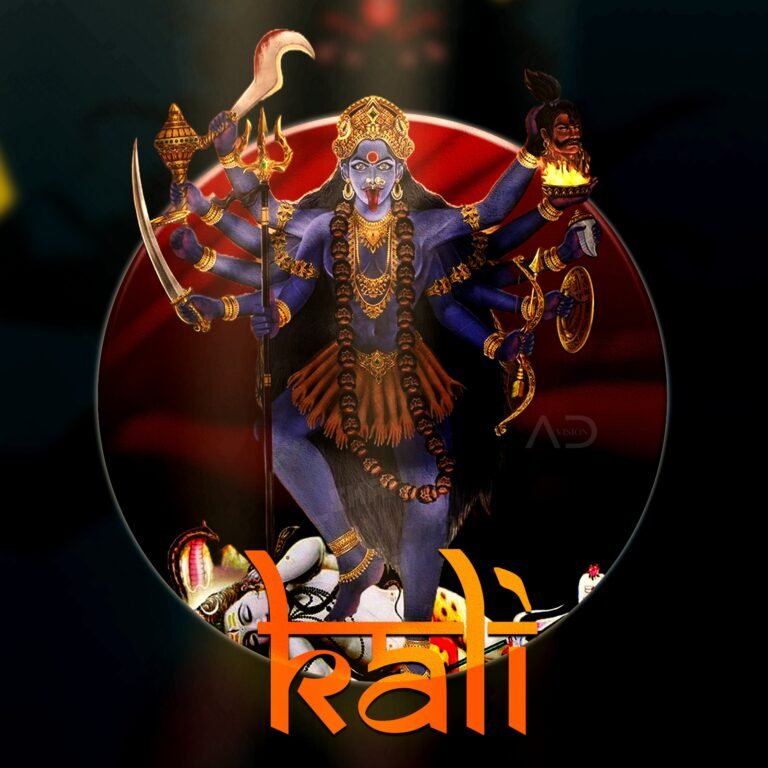
Kali, often referred to as Kalika, stands as a formidable deity within Hinduism, embodying a spectrum of cosmic forces and energies. In the tapestry of Hindu mythology, Kali is a major goddess intricately associated with time, change, creation, power, destruction, and death, encapsulating the dynamism inherent in the universe.
Within the Shaktism tradition, Kali is revered as a primary manifestation of Shakti—the divine feminine energy that animates the cosmos. Her name, derived from the Sanskrit word “Kala,” underscores her dominion over time, emphasizing the cyclical nature of existence and the perpetual dance of creation and dissolution.
Visually, Kali is often depicted with a fierce countenance, wielding weapons and adorned with a necklace of skulls—a symbol of her triumph over ego and ignorance. Her dynamic imagery signifies not only the destructive aspects of nature but also the transformative power within it.
As the first among the ten Mahavidyas in Hindu tantric tradition, Kali holds a pivotal place in spiritual practices seeking to harness and understand the potent energies of the divine. Devotees invoke her for protection, courage, and the strength to navigate the ever-changing currents of life.
Kali’s significance goes beyond mere destruction; she is a symbol of the fierce yet compassionate nature of the divine feminine. In her destructive aspect, she clears the path for new beginnings, making way for the cycles of rebirth and regeneration.
Ultimately, Kali stands as a profound representation of the eternal dance of existence, where time, creation, and destruction converge in the cosmic theater of life. Her worship is a testament to the recognition of both the ferocity and benevolence that reside within the divine, inviting devotees to embrace the full spectrum of life’s experiences with reverence and humility.
Tara: The Radiant Goddess of Felicity and Maternal Grace

Tārā, the Hindu goddess of felicity and sanguineness, graces the pantheon with her benevolent presence. Revered as the consort of Brihaspati, the god of planet Jupiter, Tārā’s essence radiates with positivity and maternal grace.
In Hindu mythology, Tārā’s significance extends beyond her role as a celestial spouse. According to certain Puranas, Tārā played a pivotal role in the celestial lineage, being the mother of Budha, the god of Mercury, through her union with Chandra, the moon god. Additionally, she bore a son named Kacha through her association with Brihaspati.
Tārā’s maternal and nurturing qualities align with her role as a source of felicity. Devotees turn to her for blessings of positivity, happiness, and the fortitude to navigate life’s myriad challenges. The association with Brihaspati, the divine teacher and guide, further reinforces her connection to wisdom and benevolence.
Her offspring, Budha and Kacha, represent the celestial forces of Mercury and the transcendent pursuit of knowledge, respectively. Tārā’s family ties underscore the interconnectedness of the cosmic forces and the divine interplay that shapes the universe.
The worship of Tārā is not only an ode to her maternal grace but also an acknowledgment of the harmonious dance of celestial bodies that influence our lives. As the consort of Brihaspati, Tārā symbolizes the harmonious alignment of planetary energies, fostering a sense of balance and positivity.
In the tapestry of Hindu mythology, Tārā emerges as a beacon of hope and maternal wisdom, guiding devotees through the ebb and flow of life’s experiences. Her benevolent presence encourages seekers to embrace sanguineness and felicity, recognizing the interconnected threads of celestial influence and the enduring power of maternal grace.
Chhinnamasta: The Unveiling of Cosmic Power and Transcendence
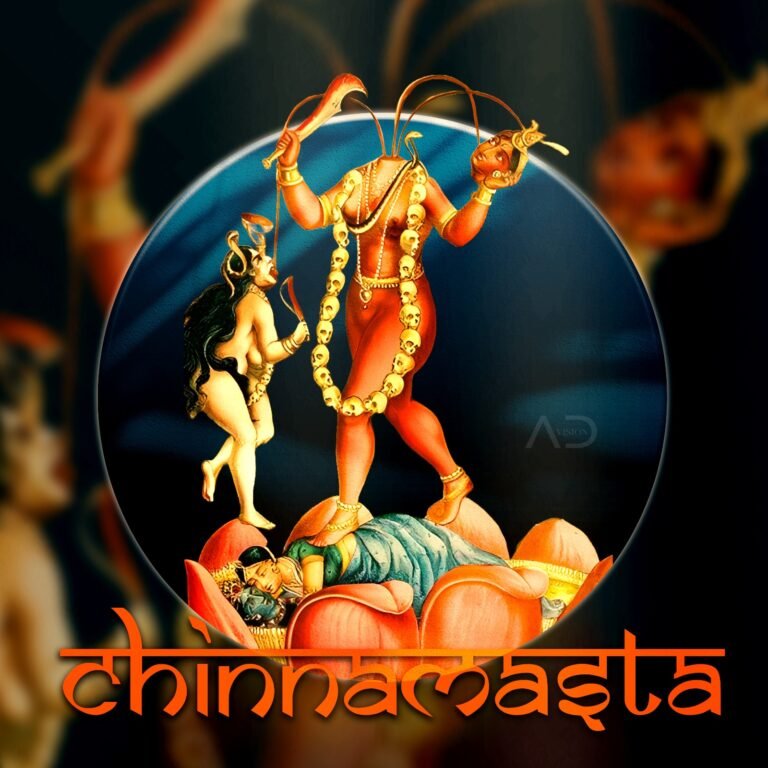
Chhinnamasta, the enigmatic goddess of Tantra, unfolds as a ferocious and awe-inspiring facet of Mahadevi, the Hindu Mother goddess. Also known as Chinnamastā or Prachanda Chandika, she is a central figure among the Mahavidyas, the ten goddesses embedded within the esoteric tapestry of Tantra.
The very name “Chhinnamasta” evokes a powerful image— “She whose head is severed.” This striking representation stands as a profound metaphor for the transcendence of the ego and the unveiling of cosmic power. In her iconography, Chhinnamasta is often depicted as a self-decapitated nude goddess, standing or seated on a divine copulating couple, holding her own severed head in one hand and a scimitar in another.
The symbolism embedded in Chhinnamasta’s form is rich with layers of meaning. Her self-decapitation signifies the transcendent nature of the goddess, beyond the limitations of the physical form and ego. The divine copulating couple beneath her feet symbolizes the cosmic union of masculine and feminine energies, the eternal dance of creation and destruction.
What sets Chhinnamasta apart is the vivid portrayal of three jets of blood spurting from her bleeding neck. In an act of divine paradox, her severed head and two attendants drink the blood, signifying the sustenance and continuity of life through sacrifice and renewal. This act encapsulates the cyclical nature of existence—death as a precursor to rebirth, destruction as a prelude to creation.
Chhinnamasta, often worshiped for her transformative and liberating energies, challenges the conventional notions of divinity. She is a force beyond duality, beyond life and death, inviting her devotees to confront the profound mysteries of existence. In embracing the ferocity of Chhinnamasta, practitioners seek to transcend the ego, recognizing the impermanence of the self and aligning with the cosmic forces that govern the universe.
As a Mahavidya, Chhinnamasta beckons seekers to delve into the esoteric realms of Tantra, where the boundaries between the sacred and the profane blur, and the divine reveals itself in the most unconventional and transformative ways. In her severed head, in the spurt of blood, in the paradox of self-sacrifice, Chhinnamasta invites those who seek her wisdom to explore the limitless dimensions of cosmic consciousness and the eternal dance of creation and destruction.
Shodashi- The sixteen-year-old form of the goddess, symbolizing love and sexuality

Shodashi (Sanskrit: षोडशी Ṣoḍaśī) is a fierce aspect of the Hindu goddess Durga, often depicted as a sixteen-year-old girl. She is associated with love, beauty, fertility, and sexual energy. She is worshipped in Tantra, a school of Hinduism that emphasizes ritual, symbolism, and the use of mantras.
Appearance:
Shodashi is typically depicted as a young woman with radiant skin and a youthful body. She has four arms, which represent her power and dominion over the four cardinal directions. She often holds a lotus flower, which symbolizes purity and enlightenment. Her other hands may hold a bow and arrow, a skull, or a drum. She is often adorned with jewelry and wears a red cloth, which symbolizes her association with passion and desire.
Symbolism:
Shodashi’s sixteen years represent the sixteen phases of the lunar cycle, which are associated with fertility and menstrual cycles. Her youthful beauty symbolizes the allure of the physical world and the power of attraction. Her fierce aspect represents the untamed power of nature and the raw energy of life.
Worship:
Shodashi is worshipped in Tantric rituals, which are often secret and involve the use of mantras, mudras (hand gestures), and yantras (geometric diagrams). These rituals are aimed at harnessing the goddess’s power for spiritual growth and liberation.
Meaning:
Shodashi’s image is a reminder that the divine is present in all aspects of life, even the seemingly mundane or taboo. She teaches us to embrace our sexuality and use it as a source of spiritual power. She also reminds us that the physical world is an illusion, and that true liberation comes from transcending it.
In Conclusion:
Shodashi is a powerful and complex goddess who embodies both the beauty and the danger of the physical world. She is a reminder that we must not be afraid of our desires, but rather learn to channel them into something positive. With her guidance, we can find liberation and enlightenment in the most unexpected places.
Tripura Sundari - The three-cities-beautiful form of the goddess, symbolizing beauty and perfection

With a name that echoes like a celestial melody, Tripura Sundari, meaning “Beautiful One of the Three Cities,” graces the Hindu pantheon as a radiant embodiment of beauty and perfection. In her intricate iconography and profound symbolism, she unveils a multifaceted tapestry of divine love, cosmic consciousness, and the ultimate potential that lies dormant within each soul.
A Vision of Ethereal Splendor:
Imagine a vision that surpasses earthly notions of beauty. Tripura Sundari is often depicted as a sixteen-year-old maiden, her youthful form symbolizing the eternal potential for renewal and grace. Seated upon a resplendent lotus flower, she exudes an otherworldly luminescence, her skin the color of burnished gold reflecting the boundless love she radiates. Her four arms, each a graceful pillar of divine power, hold objects brimming with profound meaning:
- A book, repository of sacred knowledge and wisdom, rests in one hand, reminding us that true beauty lies not just in the physical form, but in the cultivation of intellect and spirit.
- A rosary of crimson beads, adorned with lotus blossoms, graces another hand, signifying her connection to the divine, a conduit through which blessings flow towards her devotees.
- A mirror, often depicted as held between her thumb and forefinger, symbolizes self-reflection, inviting us to gaze inward and recognize the spark of divinity within ourselves.
- And finally, a sugarcane bow, with arrows tipped with five blossoming flowers, represents her playful nature and her power to pierce through illusion and reveal the ultimate reality.
Tripura: The Three Mystical Cities:
Tripura Sundari’s name alludes to her dominion over three mystical cities:
- Mahapurusha Pura: The city of the Great Person, representing the supreme consciousness, the all-encompassing Self.
- Mahavidya Pura: The city of the Great Wisdoms, housing the ten Mahavidyas, fierce aspects of the goddess embodying various cosmic forces.
- Manipurata Pura:** The city of the Jewel Network, symbolizing the subtle energy centers within the human body, through which kundalini Shakti, the divine energy, ascends.
Embracing the Tripura Sundari Within:
Worshiping Tripura Sundari is not merely an act of seeking external blessings; it is a journey of inner transformation. Through meditation, chanting mantras like the powerful “Om Sri Maha Tripura Sundari Namah,” and immersing ourselves in her artistic representations, we begin to awaken the Tripura Sundari within. We tap into the reservoir of beauty and love that resides within each of us, learning to express our authentic selves with unwavering confidence and grace.
Tripura Sundari’s message resonates far beyond the confines of religion. She beckons us to embrace the multifaceted nature of beauty, recognizing it not just in the physical form, but in the depths of our intellect, the wellspring of our compassion, and the unwavering pursuit of self-knowledge. In her divine embrace, we find the courage to shed layers of illusion, unveil our inner radiance, and step into the world as radiant expressions of the Tripura Sundari, the beautiful one who resides within us all.
Bhuvaneshwari - The world-ruler form of the goddess, symbolizing prosperity and good fortune
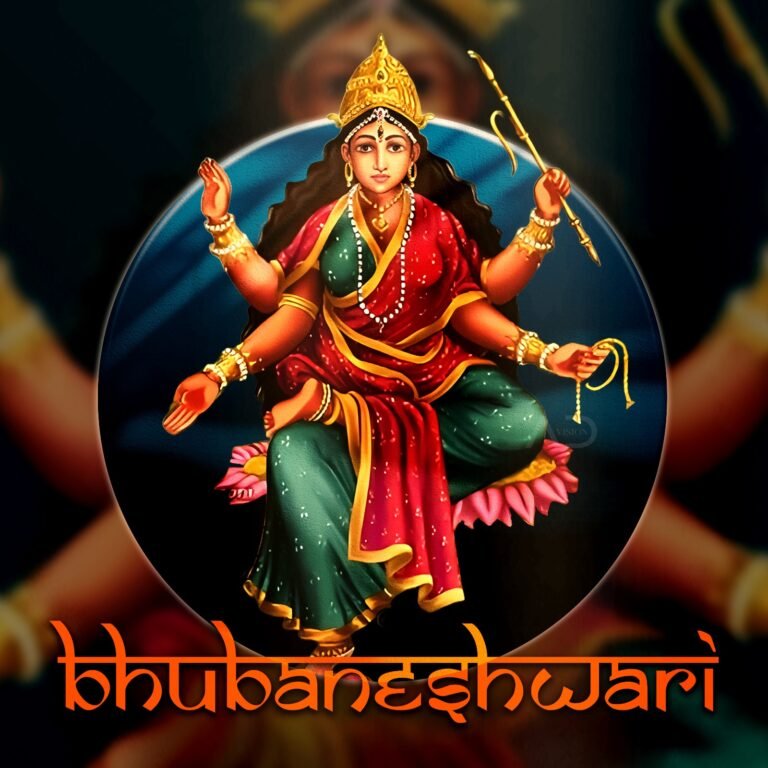
Bhuvaneshwari, the magnificent queen of the universe! Her very name, a melody in Sanskrit, translates to “Mistress of the Worlds,” aptly describing her dominion over creation itself. In the grand tapestry of Hindu goddesses, Bhuvaneshwari stands as a radiant embodiment of prosperity, good fortune, and the boundless potential that resides within each of us.
Divine Radiance:
Imagine, if you will, a vision of breathtaking beauty. Bhuvaneshwari is typically depicted seated atop a resplendent lotus flower, her serene grace echoing the stillness of a moonlit lake. Her skin, the color of burnished gold, radiates an otherworldly luminescence, reflecting the infinite wealth she bestows upon her devotees. Her four arms, graceful yet powerful, symbolize her mastery over the four cardinal directions, ensuring abundance flows from every corner of the cosmos.
Symbols of Auspiciousness:
In each hand, Bhuvaneshwari holds objects imbued with profound meaning. A book rests in one, signifying her wisdom and command over knowledge, the key to unlocking hidden treasures both material and spiritual. A rosary of beads in another hand alludes to her connection with the divine, reminding us that true prosperity transcends the earthly realm. A noose, often depicted as a lasso or gentle rope, symbolizes her power to draw in good fortune and bind it inextricably to those who seek her blessings. And finally, a goad, sometimes represented as a writing stylus, guides us towards realizing our own potential and manifesting our desires.
Bhuvaneshwari’s Embrace:
Unlike some fierce Hindu goddesses, Bhuvaneshwari exudes a gentle, welcoming aura. Her eyes, often depicted as half-closed in meditative bliss, invite us to step into her radiant embrace. She whispers promises of success, not just in worldly pursuits, but in the blossoming of our inner selves. When we pray to Bhuvaneshwari, we tap into the universal wellspring of abundance, drawing forth not just material wealth, but creativity, knowledge, and the strength to manifest our dreams.
Celebrating Bhuvaneshwari:
Devotion to Bhuvaneshwari finds expression in a multitude of ways. Chanting mantras dedicated to her, like the powerful “Om Hrim Shrim Bhuvaneshvari Namah,” opens the channel to her blessings. Observing rituals like Bhuvaneshwari Jayanti, her birth anniversary, brings communities together in joyous celebration. Artistic representations, from intricate temple carvings to soulful devotional songs, capture her essence and inspire countless hearts.
In conclusion:
Bhuvaneshwari is more than just a goddess; she is a guiding force, a radiant promise of a life brimming with possibility. By attuning ourselves to her frequency, we connect to the boundless abundance that exists within and around us, paving the way for a journey of flourishing and fulfillment. So, let us open our hearts to the blessings of Bhuvaneshwari, the benevolent queen of the universe, and watch as our lives blossom like the lotus upon which she rests.
Bhairavi - The fierce form of the goddess, symbolizing power and courage
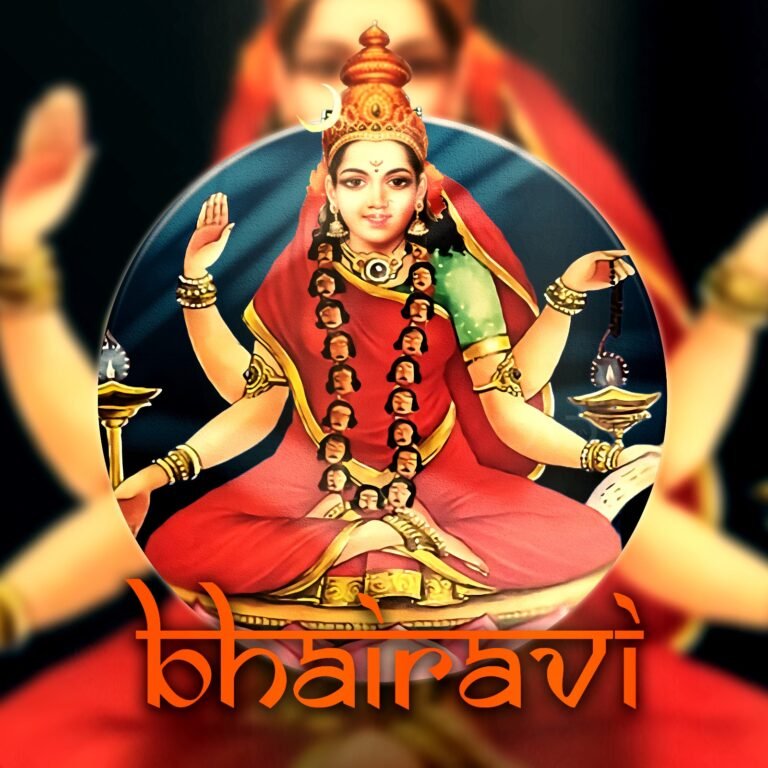
With eyes that crackle like electric storms and a mane of windswept tresses, Bhairavi, the fierce aspect of the Hindu goddess Durga, personifies raw power and unyielding courage. Her very name, meaning “Terrible” or “Formidable,” sends shivers down the spines of demons and whispers of strength to the hearts of devotees.
A Vision of Untamed Might:
Imagine a warrior queen forged in the fires of cosmic creation. Bhairavi is often depicted as a fearsome figure, her four arms wielding fearsome weapons: a skull-topped staff, a trident dripping with blood, a sword that cleaves illusions, and a bowl brimming with intoxicating libations. Her bared fangs and wild, bloodshot eyes exude an aura of untamed power, a force that shatters fear and ignites the will to conquer.
Beyond Destruction, Liberation:
Bhairavi’s ferocity is not born of malice, but of an unwavering commitment to vanquishing negativity and protecting the innocent. She is the ultimate warrior goddess, her wrath a purifying fire that consumes ignorance, injustice, and the demons that lurk within and without.
The Path of the Bhairava Sadhana:
Bhairavi is not just a fearsome deity; she is a potent symbol for spiritual seekers. Her worship, known as Bhairava Sadhana, is a path of intense self-exploration and transformation. Through ritual practices, meditations, and invocations, devotees channel Bhairavi’s fierce energy to confront their inner demons, overcome limitations, and awaken their dormant potential.
The Roar of the tigress Within:
Bhairavi’s message resonates far beyond the confines of Hindu tradition. She beckons us to tap into the power that lies dormant within, the tigress within that roars in the face of adversity. She teaches us to confront challenges with unwavering courage, to embrace our shadow selves, and to rise above fear and self-doubt.
In a world that often demands conformity and timidity, Bhairavi stands as a beacon of unyielding strength and fierce compassion. She reminds us that true power lies not in domination, but in the courage to be true to ourselves, to stand up for what is right, and to blaze our own trail of light through the darkness.
So, let the roar of the Bhairavi within guide you. Embrace your inner warrior, conquer your fears, and step into the world with the unyielding strength and fierce compassion of this formidable goddess.
Dhumavati - The smoke-veiled form of the goddess, symbolizing disease and death

Dhumavati, draped in the veil of smoke and embers, emerges from the shadows of the Hindu pantheon. Unlike the vibrant hues of other goddesses, she cloaks herself in the ashen embrace of death, disease, and dissolution. Yet, within this unsettling visage lies a hidden wisdom, a profound understanding of the transformative power inherent in endings.
A Visage of Fiery Transformation:
Imagine a skeletal figure, her emaciated form draped in crimson cloth, riding a crow through a burning pyre. Her wild, windswept hair crackles with flames, and her eyes, like smoldering embers, pierce the veil between worlds. This is Dhumavati, the goddess of smoke, embodiment of the impermanence that underpins all existence.
Beyond Destruction, Renewal:
Though often misinterpreted as a harbinger of ill fortune, Dhumavati’s true essence lies in transformation. The smoke that shrouds her represents the dissolution of all that is finite, be it physical form, worldly attachment, or egoic clinging. In the ashes of destruction, she sows the seeds of renewal, reminding us that endings are not merely loss, but fertile ground for rebirth.
The Power of Letting Go:
Dhumavati’s worship, particularly in Tantric traditions, offers a path of radical self-confrontation. Through meditation, visualization, and rituals involving fire and offerings, devotees surrender to the transformative power of death. They confront their fears of impermanence, release attachments, and embrace the ever-changing nature of reality.
The Smoke Within:
Dhumavati’s message transcends the confines of Hindu theology. She whispers to our modern anxieties about mortality, reminding us that clinging to the impermanent ultimately leads to suffering. By embracing the “Dhumavati” within, the smoke of self-doubt and fear, we can release its hold on us and open ourselves to the transformative fires of change.
Emerging from the Ashes:
Just as the phoenix rises from the ashes, Dhumavati beckons us to step through the flames of our own limitations. In letting go of outdated selves, rigid structures, and limiting beliefs, we pave the way for a more authentic, open, and ever-evolving existence.
So, next time you encounter the unsettling visage of Dhumavati, remember: she is not a harbinger of doom, but a potent reminder of the transformative power that lies within every ending. Embrace the smoke, release the clinging, and emerge from the ashes, reborn and renewed.
Bagalamukhi - The tongue-tied form of the goddess, symbolizing the power to defeat enemies
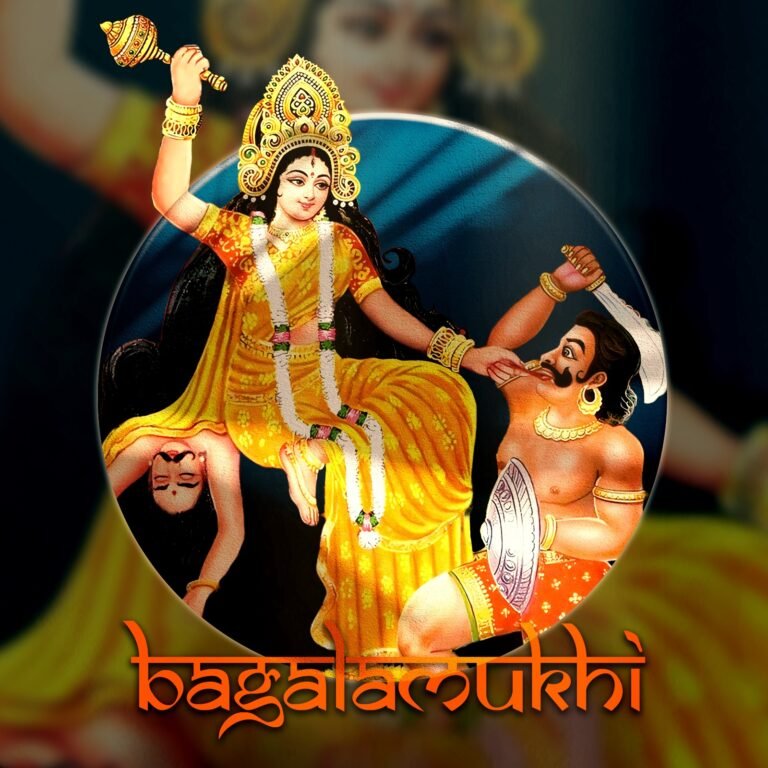
With eyes that pierce like lightning and a grimace that freezes the blood, Bagalamukhi, the “speech-confounding” goddess, stands as a formidable force in the Hindu pantheon. Unlike most deities who woo with blessings and boons, Bagalamukhi’s domain lies in the shadows, where she wields the potent power to silence, subdue, and utterly vanquish enemies.
A Vision of Uncompromising Power:
Imagine a warrior queen sculpted from moonlight and draped in saffron cloth. Her four arms radiate power, wielding a club, a noose, a skull-topped staff, and a damaru (hand drum). Her tongue, protruded in a fearsome grimace, paralyzes with the echo of unspoken curses and silenced pleas. This is Bagalamukhi, the terror of evildoers and the shield of the wronged.
Beyond Curses, Control:
While often associated with spells and potent curses, Bagalamukhi’s true power lies in control. Her tongue, symbolizing communication and influence, binds the speech of her enemies, rendering their plots impotent and their words meaningless. She severs the thread of their machinations, leaving them adrift in a sea of their own impotent rage.
The Path of Shatkarma Sadhana:
Bagalamukhi’s worship, known as Shatkarma Sadhana, is a transformative journey for those seeking to overcome negativity and reclaim their power. Through intricate rituals, mantras like the powerful “Om Hrim Mahabagalamukhiye Sarvadushtaanaam Stambhanaam Kuru Kuru Swaha,” and fierce visualizations, devotees tap into the goddess’s energy. They learn to control their own speech, thoughts, and emotions, wielding them with precision to silence internal negativity and external threats.
The Whisper Within:
Bagalamukhi’s message resonates far beyond the confines of Hindu tradition. She beckons us to harness the power of our own words and thoughts, to silence the inner critic and negative self-talk, and to speak with unwavering conviction and truth. In a world rife with misinformation and manipulation, she empowers us to reclaim control of our narrative and use our voices for positive change.
Silencing the Shadows:
In a world where voices vie for attention and negativity often dominates, Bagalamukhi stands as a beacon of clarity and control. She teaches us to wield our words like weapons, not of harm, but of self-protection and empowerment. With her fierce embrace, she silences the shadows within and without, paving the way for a life of authenticity, purpose, and unwavering inner strength.
So, the next time you face a formidable foe, remember the whisper of Bagalamukhi. Let her silence their machinations, empower your voice, and guide you towards a victory bathed in the moonlight of her unwavering protection.
Matangi - The speech-giving form of the goddess, symbolizing knowledge and music
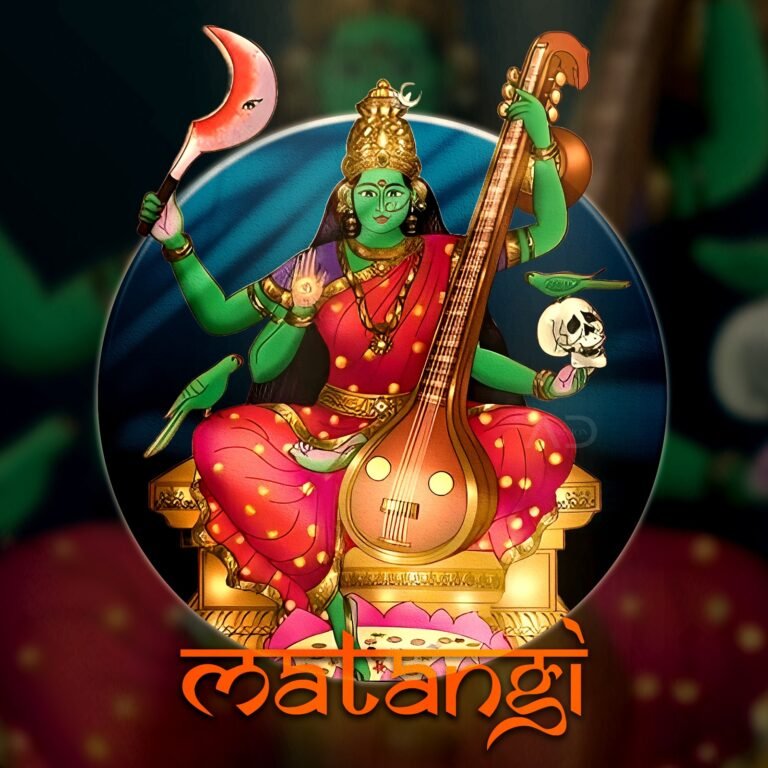
With hands that strum the celestial veena and eyes that shimmer like twilight sapphires, Matangi, the “speech-giving” goddess, steps forward from the vibrant tapestry of the Hindu pantheon. Unlike many deities who embody purity and grace, Matangi embraces the wild and unconventional, weaving melodies of knowledge and creativity from the margins of societal norms.
A Vision of Eclectic Brilliance:
Imagine a vision that pulsates with an untamed spirit. Matangi is often depicted as a youthful woman, adorned with vibrant crimson cloth and sparkling jewels. Her emerald skin, sometimes streaked with ash, speaks of her association with the overlooked and the unconventional. She holds a veena, the stringed instrument of Saraswati, goddess of learning and music, but her playing carries a wilder rhythm, a melody born from the untamed corners of the universe.
Beyond Boundaries, Unveiling Knowledge:
While Saraswati represents the classical knowledge of the Brahmins, Matangi embodies the “extraordinary” wisdom that lies beyond societal boundaries. She is the patron of outcast communities, the Dalits and the marginalized, those whose voices were traditionally silenced. In their discarded food and unconventional practices, she finds not impurity, but hidden knowledge waiting to be revealed.
The Power of Unchained Speech:
Matangi’s power lies not just in her music, but in her ability to give voice to the voiceless. Her chants and spells, often considered “impure” by orthodox society, hold the power to break curses, unleash creativity, and grant mastery over the arts. Through her, the ostracized find their voice, the unheard are finally heard, and the boundaries of knowledge are shattered in a symphony of liberation.
The Path of Matangi Sadhana:
Worshiping Matangi, through rituals known as Matangi Sadhana, is a journey for those seeking to unlock their hidden potential and express their authentic selves. Through meditation, chanting mantras like the powerful “Om Kleem Matangaye Namah,” and engaging in artistic pursuits, devotees tap into the goddess’s boundless energy. They learn to embrace their own unconventional qualities, overcome societal limitations, and unleash their voices in a chorus of self-expression.
The Melody Within:
Matangi’s message vibrates far beyond the confines of Hindu tradition. She beckons us to embrace the outcast within, the parts of ourselves deemed unacceptable by society. She encourages us to break free from the cages of conformity, to unleash our unique voices, and to weave our own melodies of creativity and knowledge.
An Anthem for the Marginalized:
In a world that often silences the marginalized and celebrates the mainstream, Matangi stands as a defiant hymn for the unconventional. She reminds us that the most powerful music often arises from the fringes, that true knowledge blooms in the unexpected corners, and that our voices, untamed and authentic, are the most potent tools for personal and societal transformation.
So, the next time you hear a melody that stirs your soul, remember the vibrant essence of Matangi. Let her wild notes guide you, unleash your voice, and dance to the rhythm of your own unconventional brilliance.
We Are Currently Raising Funds For The Ten Mahavidya Temple
Together, we can build a brighter future, brick by brick, and open the doors of sanctuary to even more souls.
Here’s how you can help:
- Make a one-time donation: Every rupee counts. Choose an amount that resonates with you and witness the impact of your generosity.
- Become a monthly donor: Join our circle of committed supporters and ensure the temple’s ongoing growth and service.
